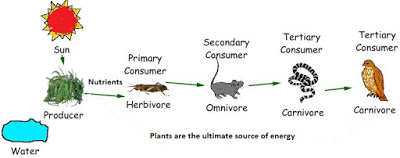Excercise
Q 1. Why do organisms need to take food?
Ans: All organisms need to take food to get energy for the growth, development and maintenance of their bodies. The life process include nutrition, respiration, growth, excretion, reproduction and response to stimuli which can only be done by intake of food.
Q 2. Distinguish between a parasite and a saprotroph.
Ans:
|
S.No. |
Parasite |
Saprotroph |
| 1. | The organism that grows on the body of another organism and derives nutrients from it is known as a parasite. | The organism that obtains nutrients from the dead or decaying organic matter is called saprotroph. |
| 2. | They take the readymade food from the host. | They take the digested and decayed food. |
| 3. | They directly feed on living organisms for their nutrition. | They feed on dead and decaying organism. |
| 4. | Examples- Cuscuta (amar bel) & orchids. | Examples- Fungi and Mushrooms |
Q 3. How would you test the presence of starch in leaves?
Ans:Steps to test the presence of starch in leaves :
Step 1: A fresh leaf is taken.
Step 2: The leaf is boiled in water for few minutes to kill the cells in the leaf.
Step 3: Now, dip this leaf in iodine solution.
Step 4: The color of the leaf will changes into blue black color when iodine is added to it which shows the presence of starch in it.
Q4. Give a brief description of the process of synthesis of food in green plants.
Ans: Photosynthesis is the process synthesis of food in the plants with the help of chlorophyll and carbon dioxide in the presence of sunlight.
Water and minerals present in the soil are absorbed by the roots and transported to the leaves by the vessels. Carbon dioxide from air is taken through stomata present in leaves. Leaves are the food factories of the plants which capture the energy of the sunlight with the help of chlorophyll. This energy is used to synthesize food from carbon dioxide and water.
Q5. Show with the help of a sketch that the plants are the ultimate source of food.
Ans: The food chain shows that the plant is the ultimate producer. Only plant can produce food and rest of other organisms are directly or indirectly dependent on it. The following sketch shows some examples of plant dependency.

Q6. Fill in the blanks:
(a) Green plants are called _________________ since they synthesise their own food.
(b) The food synthesised by the plants is stored as _________________.
(c) In photosynthesis solar energy is captured by the pigment called ___________.
(d) During photosynthesis plants take in ______________________ and release __________________.
Ans:
(a) Green plants are called autotrophs since they synthesise their own food.
(b) The food synthesised by the plants is stored as starch.
(c) In photosynthesis solar energy is captured by the pigment called chlorophyll.
(d) During photosynthesis plants take in carbon dioxide and release oxygen.
Q7. Name the following:
(i) A parasitic plant with yellow, slender and tubular stem.
(ii) A plant that has both autotrophic and heterotrophic mode of nutrition.
(iii) The pores through which leaves exchange gases.
Ans:
(i) Cuscuta (Amarbel)
(ii) Pitcher plant
(iii) Stomata
Q8. Tick the correct answer:
(a) Amarbel is an example of:
(i) autotroph
(ii) parasite
(iii) saprotroph
(iv) host
Ans: (ii) parasite
(b) The plant which traps and feeds on insects is:
(i) Cuscuta
(ii) china rose
(iii) pitcher plant
(iv) rose
Ans: (iii) pitcher plant
Q 9. Match the items given in Column I with those in Column II:
| Column I | Column II |
| Chlorophyll | Bacteria |
| Nitrogen | Heterotrophs |
| Amarbel | Pitcher Plant |
| Animals | Leaf |
| Insects | Parasite |
Ans:
| Column I | Column II |
| Chlorophyll | Leaf |
| Nitrogen | Bacteria |
| Amarbel | Parasite |
| Animals | Heterotrophs |
| Insects | Pitcher Plant |
Q 10. Mark ‘T’ if the statement is true and ‘F’ if it is false:
(i) Carbon dioxide is released during photosynthesis.
(ii) Plants which synthesise their food themselves are called saprotrophs.
(iii) The product of photosynthesis is not a protein.
(iv) Solar energy is converted into chemical energy during photosynthesis.
Ans:
(i) Carbon dioxide is released during photosynthesis. (False)
(ii) Plants which synthesise their food themselves are called saprotrophs. (False)
(iii) The product of photosynthesis is not a protein. (True)
(iv) Solar energy is converted into chemical energy during photosynthesis. (True)
Q 11. Choose the correct option from the following:
Which part of the plant takes in carbon dioxide from the air for photosynthesis?
(i) Root hair
(ii) Stomata
(iii) Leaf veins
(iv) Sepals
Ans: (ii) Stomata
Q 12. Choose the correct option from the following:
Plants take carbon dioxide from the atmosphere mainly through their:
(i) roots
(ii) stem
(iii) flowers
(iv) leaves
Ans: (iv) leaves
